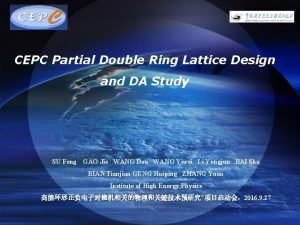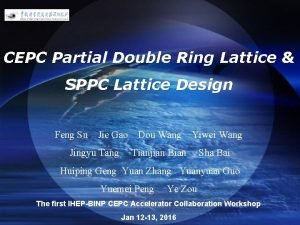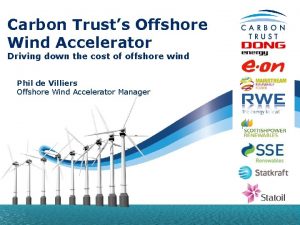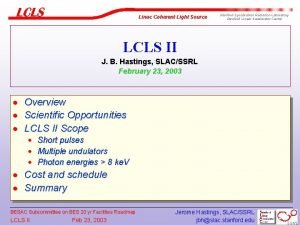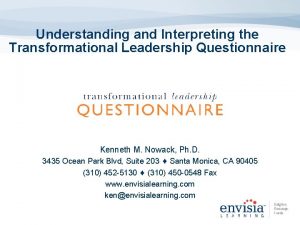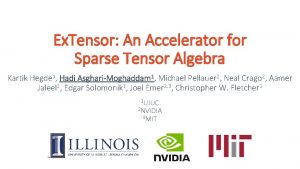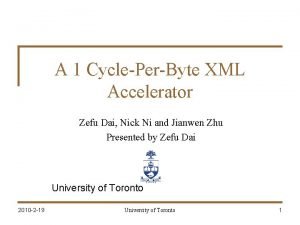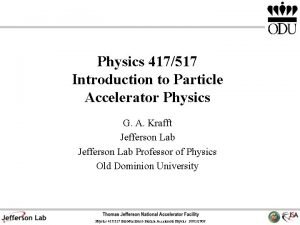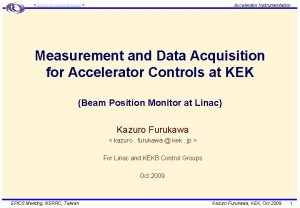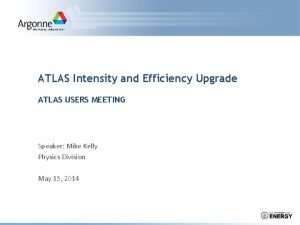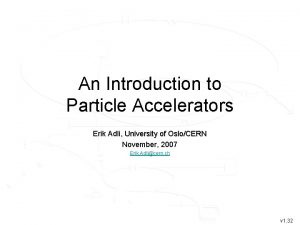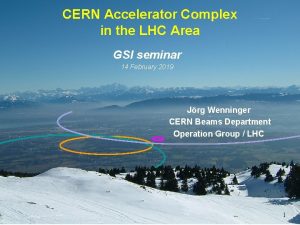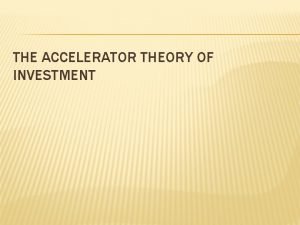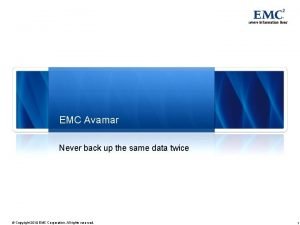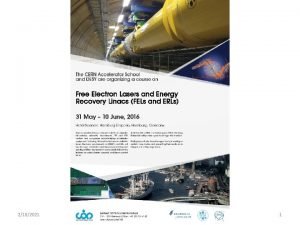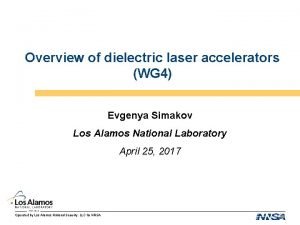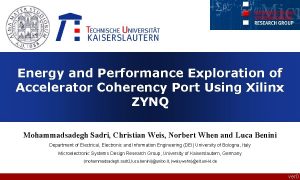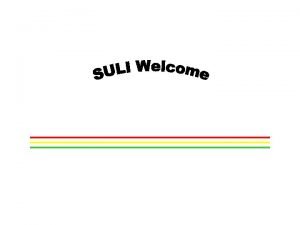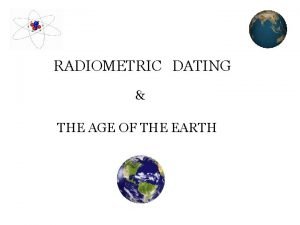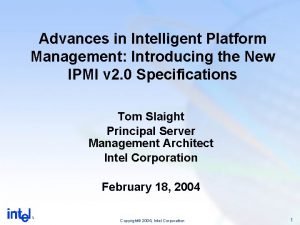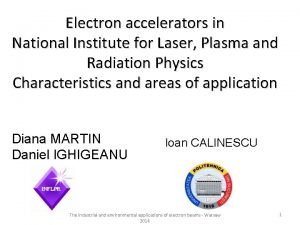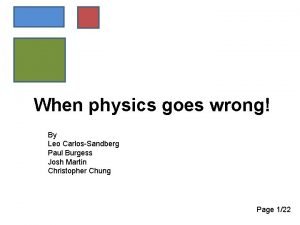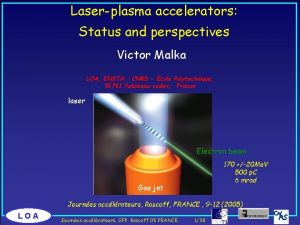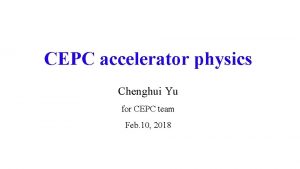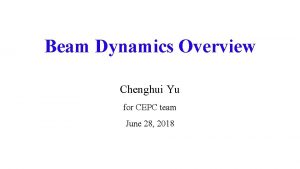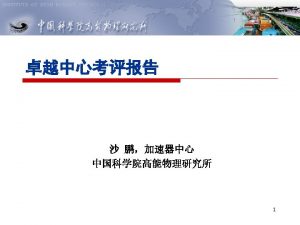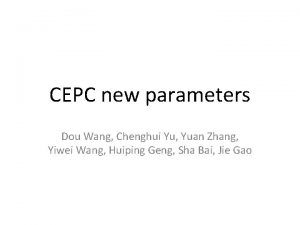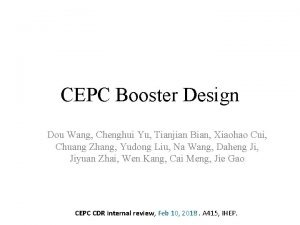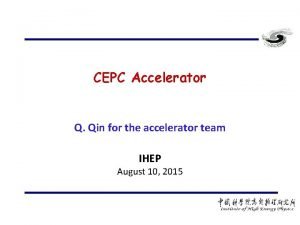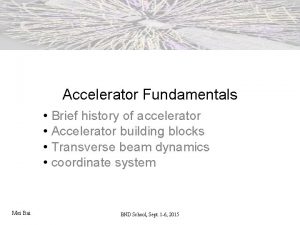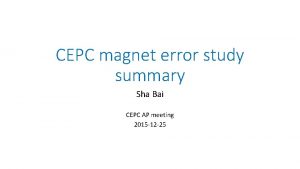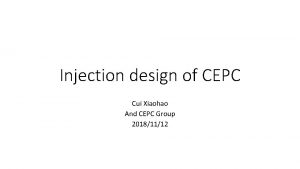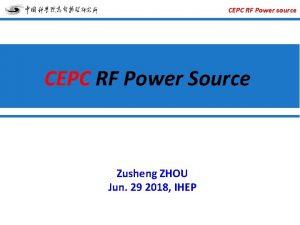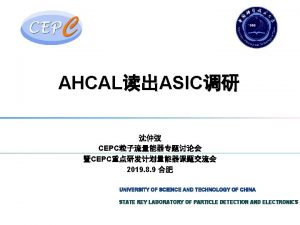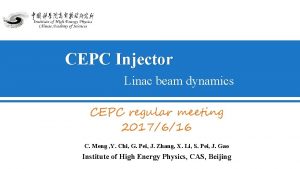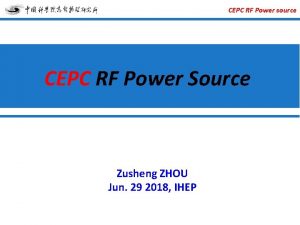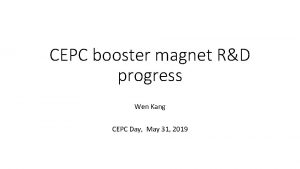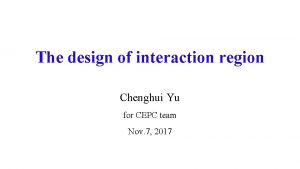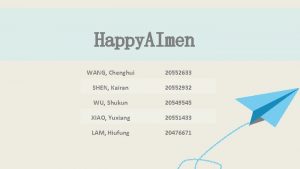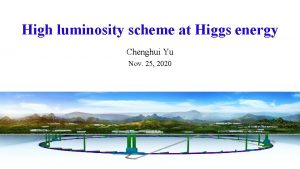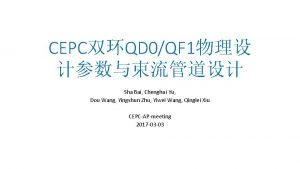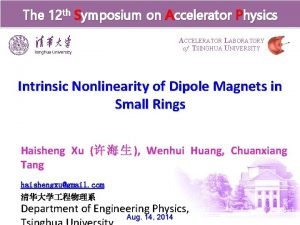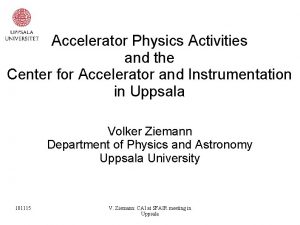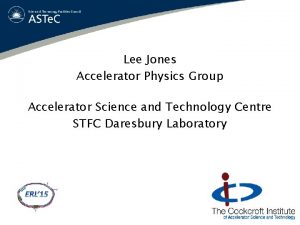CEPC accelerator physics Chenghui Yu for CEPC team





































- Slides: 37

CEPC accelerator physics Chenghui Yu for CEPC team Nov. 6, 2017

Outline • Physics goals and collider parameters • Physics design of CEPC Linac Booster Collider ring • Summary

Physics goals of CEPC Electron-positron collider (45. 5, 80, 120 Ge. V) – Higgs Factory • Precision study of Higgs (m. H, JPC, couplings) • Looking for hints of new physics • Luminosity > 2. 0× 1034 cm-2 s-1 – Z & W factory • Precision test of standard model • Rare decays • Luminosity > 1. 0× 1034 cm-2 s-1

Key parameters of CEPC • • • 100 km circumference, double ring collider with 2 IPs Matching the geometry of SPPC as much as possible Adopt twin-aperture quadrupoles and dipoles in the ARC Detector solenoid 3. 0 T with length of 7. 6 m while anti-solenoid 7. 2 T Maximum gradient of quadrupole 151 T/m (3. 7 T in coil) Tapering of magnets along the ring Two cell & 650 MHz RF cavity Two dedicated surveys in the RF region for Higgs and Z modes Maximum e+ beam power 30 MW & e- 30 MW Crab-waist scheme with local X/Y chromaticity correction Common lattice for all energies.

Physics design of CEPC Linac Booster Collider ring

Physics design of CEPC Linac 1200 m Parameter Symbol Unit Baseline Designed e- /e+ beam energy Ee-/Ee+ Ge. V 10 10 frep Hz 100 Ne-/Ne+ > 6. 25× 109 1. 9× 1010 / 1. 9× 1010 n. C > 1. 0 3. 0 Repetition rate e- /e+ bunch population Energy spread (e- /e+ ) σe < 2× 10 -3 1. 5× 10 -3 / 1. 2× 10 -3 Emittance (e- /e+ ) εr nm rad < 300 5 / 120 Ge. V 4 4 n. C 10 e- beam energy on Target e- bunch charge on Target

Physics design of CEPC Transport Line 1 550 m 0 ~ -100 m Transfer efficiency 99%

Physics design of CEPC Booster Injection energy 10 Ge. V FODO cells with 90 degrees phase shift • The diameter of the inner aperture is selected as 55 mm due to limitation of impedance. • The beam lifetime should be higher than 14 min (3% particle lose) according to the duration before extraction. The definition of BSC is 2(3 +5 mm) which is the basic requirement.

Physics design of CEPC Booster Injection time structure 28 s 185 s 30 Gauss @ 10 Ge. V 318 s Eddy current effect

Physics design of CEPC Booster Higgs W Z Injection Energy (Ge. V) 120 80 45. 5 Bunch number 286 1044 2180 Bunch Charge (n. C) 0. 62 0. 173 0. 077 Beam Current (m. A) 0. 532 0. 542 0. 504 Beam current threshold due to TMCI (m. A) Number of Cycles 0. 803 1 5 5 Current decay 3% 3% 3% Ramping Cycle (sec) 10 6 2 Injection time (sec) 28 185 318 Collider Lifetime (hour) 0. 33 3. 5 7. 4 Injection frequency (sec) 37 383 811 Transfer efficiency is 92% if beam lifetime is 14 min.

Physics design of CEPC Booster Error studies Errors Setting Dipole Quadrupole Sextupole Corrector Transverse shift X/Y (μm) 100 100 Longitudinal shift Z (μm) 150 150 Tilt about X/Y (mrad) 0. 1 0. 2 Tilt about Z (mrad) 0. 05 0. 2 Nominal field 1 e-3 1 e-2 BPM Accuracy (m) 1 e-5 Tilt (mrad) 10 Gain 5% Offset after BBA(mm) 1 e-3

Physics design of CEPC Booster Orbit with errors • Orbit within the beam stay clear • “First turn trajectory” is not necessary Horizontal Corrector: 48 correctors +856 BTs Vertical Corrector : 904 correctors BPM : 904*2 Hor. 0. 2 mm Ver. 0. 3 mm

Physics design of CEPC Booster Beta Beating, Emittance and Dynamic Aperture with errors • • Nearly half of bare lattice, 50 mm* 18 mm, without optics correction, satisfy requirement Emittance growth is less than 10% for the simulation seeds Satisfy the requirement of injection and beam lifetime Skew quadrupoles are needed to control the coupling βx/βy=188/33 m Hor. 10% Ver. 6. 5% Hor. 0. 023 m Ver. 0. 04 m =300 nm: 2(6 x +5 mm) / 2(4 y +5 mm) =120 nm : 2(9 x +5 mm) / 2(6 y +5 mm)

Physics design of CEPC Booster On-axis injection and extraction Damping time 87 s • • e+ and e- beams are injected from outside of the booster ring Horizontal septum is used to bend beams into the booster A single kicker downstream of injected beams kick the beams into the booster orbit Extraction is the opposite procedure

Physics design of CEPC Transport Line 2 480 m 1. 5 m Transfer efficiency 99% • The total transfer efficiency > 90% (99%*92%*99%) • Satisfy the requirement of topup operation for H, W and Z

Physics design of CEPC Collider ring The geometry of CEPC is compatible with the SPPC as much as possible

Parameters of CEPC collider ring Number of IPs Energy (Ge. V) Circumference (km) SR loss/turn (Ge. V) Crossing angle (mrad) Piwinski angle Ne/bunch (1010) Bunch number Beam current (m. A) SR power /beam (MW) Bending radius (km) Momentum compaction (10 -5) IP x/y (m) Emittance x/y (nm) Transverse IP (um) x/ y/IP RF Phase (degree) VRF (GV) f RF (MHz) (harmonic) Nature bunch length z (mm) Bunch length z (mm) HOM power/cavity (kw) Energy spread (%) Energy acceptance requirement (%) Energy acceptance by RF (%) Photon number due to beamstrahlung Lifetime due to beamstrahlung (hour) Lifetime (hour) F (hour glass) Lmax/IP (1034 cm-2 s-1) Higgs 120 1. 68 2. 75 12. 9 286 17. 7 30 1. 21/0. 0036 20. 9/0. 086 0. 024/0. 094 128 2. 14 2. 72 3. 48 0. 46 (2 cell) 0. 098 1. 21 2. 06 0. 25 1. 0 0. 33 (20 min) 0. 93 2. 0 W 2 80 100 0. 33 33 4. 39 3. 6 5220 90. 3 30 10. 9 1. 14 0. 36/0. 002 0. 54/0. 0018 13. 9/0. 060 0. 009/0. 055 134. 4 0. 465 650 2. 98 3. 7 0. 32(2 cell) 0. 066 Z 45. 5 0. 035 10. 8 1. 6 10900 83. 8 2. 9 0. 17/0. 0029 7. 91/0. 076 0. 005/0. 0165 138. 6 0. 053 3. 67 5. 18 0. 11(2 cell) 0. 037 1. 48 0. 11 0. 75 0. 08 3. 5 0. 96 4. 1 7. 4 0. 986 1. 0

Physics design of CEPC Collider ring The definition of beam stay clear • To satisfy the requirement of injection: BSC > 16 x @ Higgs • To satisfy the requirement of beam lifetime after collision BSC > 16 y Beam tail distribution with full crab-waist BSC>16 x BSC>16 y BSC_x = (20 x +3 mm), BSC_y = (30 y +3 mm), While coupling=1%

Physics design of CEPC Collider ring The design of interaction region L*=2. 2 m, c=33 mrad, βx*=0. 36 m, Detector solenoid=3. 0 T – Lower strength requirements of anti-solenoids (~7. 2 T) – Enough space for the SC quadrupole coils in two-in-one type (Peak field 3. 7 T & 151 T/m) with room temperature vacuum chamber – The control of SR power from the superconducting quadrupoles.

Physics design of CEPC Collider ring The design of interaction region Without tungsten shield.

Physics design of CEPC Collider ring The design of interaction region Rutherford Nb. Ti-Cu Cable Single aperture of QD 0 (Peak field 3. 5 T) Single aperture of QF 1 (Peak field 3. 7 T) Room-temperature vacuum chamber with a clearance gap of 4 mm Central field Magnet gradient (T/m) Magnetic Width of Beam stay length (m) clear (mm) harmonics of integral field(× 10 -4) Min. distance between beams centre (mm) QD 0 151 1. 73 19. 15 72. 61 QF 1 102 1. 48 29. 0 146. 20 Shield coil in the apertures Design of superconducting QF and QD coils n 2 3 4 5 6 7 8 9 10 11 12 Bn/B 2@R=9. 6 mm 10000. 0 0. 113106 1. 052949 -0. 50883 -0. 46465 -0. 11318 -0. 01595 -0. 01112 -0. 05347 -0. 00067 9. 01 E-05

Physics design of CEPC Collider ring The design of interaction region 3 T & 7. 6 m Anti-solenoid Central field(T) Magnetic length(m) Conductor (Nb. Ti-Cu) Coil layers Excitation current(k. A) Stored energy (KJ) Inductance(H) Peak field in coil (T) Number of sections Solenoid coil inner diameter (mm) Solenoid coil outer diameter (mm) Total Lorentz force Fz (k. N) Cryostat diameter (mm) Before QD 0 7. 2 1. 1 4× 2 mm 12 2. 2 330 0. 136 7. 4 3 120 196 -78 Within QD 0 2. 8 1. 73 4× 2 mm 6 1. 7 185 0. 13 2. 9 9 190 262 -11 500 After QD 0 1. 8 1. 98 4× 2 mm 4 1. 2 64 0. 09 1. 9 7 314 390 89 Bzds within 0~2. 12 m. Bz < 460 Gauss away from 2. 12 m with local cancellation structure The skew quadrupole coils are designed to make fine tuning of Bz over the QF&QD region instead of the mechanical rotation.

Physics design of CEPC Collider ring The design of interaction region Survey and Lattice Crab-waist scheme with local chromaticity correction ~4 km

Physics design of CEPC Collider ring The design of interaction region • The central part is Be pipe with the length of 14 cm and inner diameter of 28 mm. • IP upstream: Ec < 100 ke. V within 400 m. Last bend(66 m)Ec < 47 ke. V • IP downstream: Ec < 300 ke. V within 250 m, first bend Ec < 95 ke. V Reverse bending direction of last bends Background control & SR protection

Physics design of CEPC Collider ring The design of interaction region The total SR power generated by the QD magnet is 603 W in horizontal and 157 W in vertical. The critical energy of photons is about 1. 3 Me. V. SR power is 186 W in vertical and the critical energy of photons is about 423 ke. V. The total SR power generated by the QF 1 magnet is 1387 W in horizontal and 30 W in vertical. . The critical energies of photons are about 1. 5 Me. V and 189 ke. V in horizontal and vertical. No SR hits directly on the beryllium pipe. SR power contributed within 10 x will go through the IP.

Physics design of CEPC Collider ring The design of interaction region Assembly (preliminary) 1, IP Chamber 3, SC Magnet and Vacuum chamber (remotely) 2, Bellows and Lumical (remotely) 4, Move Lumical back and attach to the cover of cryostat with alignment holes (remotely)

Physics design of CEPC Collider ring The design of interaction region Crotch region design (preliminary) Helicoflex

Physics design of CEPC Collider ring The ARC region – Distance of two ring is 0. 35 m to adopt twin-aperture Q & B magnets. – FODO cell, 90 /90 , non-interleaved sextupole scheme

Physics design of CEPC Collider ring The RF region – Common cavities for Higgs mode, bunches filled in half ring for e+ and e-. – Independent cavities for W & Z mode, bunches filled in full ring. – The outer diameter of RF cavity is 1. 5 m. Distance of two ring is 1. 0 m. Z mode: Bunch spacing > 25 ns 10900 bunches: 28 ns

Physics design of CEPC Collider ring The RF region Low beta functions in the RF region to reduce the instabilities caused by RF cavities. For Z mode, due to the limitation of HOM 466 m. A can be chosen before the installation of the dedicated RF cavity. ~1. 0 km RF cavities RF cavities Esep=1. 8 MV/m , Lsep=50 m

Physics design of CEPC Collider ring The injection

Physics design of CEPC Collider ring The injection Injected Beam Circulating Beam Local bump kickers Off-axis injection

Physics design of CEPC Collider ring Crab waist=100% Dynamic aperture optimization SAD is used Code: MODE 200 turns tracked 100 samples IR sextupoles + 32 arc sextupoles (Max. free various=254) • Damping at each element • RF ON • Radiation fluctuation ON • Sawtooth on with tapering • The requirements • • Minimum DA of 100 samples. 0. 3% coupling. 200 turns. Dynamic Aperture of on-momentum particles

Physics design of CEPC Collider ring Crab waist=100% Dynamic aperture optimization • SAD is used • 3000 turns tracked • IR sextupoles + 32 arc sextupoles (Max. free various=254) • Damping at each element • RF ON • Radiation fluctuation ON • Sawtooth on with tapering • The requirements Z mode Minimum DA of 100 samples. 1. 7% coupling. 3000 turns. All effects (exception: errors and solenoid) is included in the dynamic aperture survey. Dynamic Aperture of on-momentum particles

Physics design of CEPC Collider ring Beam performance with errors • 2968 BPMs, 1502 horizontal and 1460 vertical correctors are used for the orbit correction. • If IR is included, the optics will be very sensitive to the errors. We haven’t find a good solution of optics correction with sextupoles for the whole ring till now. RMSCOD 24 um (x) and 38 um (y) along the ring after orbit correction

Physics design of CEPC Collider ring The impedance and instabilities Components Number R, kΩ L, n. H Z||/n, mΩ Resistive wall - 15. 3 866. 8 16. 3 432. 3 23. 0 RF cavities 336 11. 2 -72. 9 -1. 4 315. 3 0. 41 Flanges 20000 0. 7 145. 9 2. 8 19. 8 2. 8 BPMs 1450 0. 53 6. 38 0. 12 13. 1 0. 3 Bellows 12000 2. 3 115. 6 2. 2 65. 8 2. 9 Pumping ports 5000 0. 01 1. 3 0. 02 0. 4 0. 6 IP chambers 2 0. 8 0. 02 6. 7 1. 3 Electro-separators 22 1. 5 -9. 7 0. 2 41. 2 0. 2 Taper transitions 164 1. 1 25. 5 0. 8 50. 9 0. 5 32. 9 1079. 7 20. 6 945. 4 32. 1 Total kloss, V/p. C ky, k. V/p. C/m At the design bunch intensity, the bunch length will increase 30% and 40% for H and Z respectively. Bunch spacing >25 ns will be needed to eliminate the electron cloud instability.

Summary • The physical design can meet the basic luminosity requirements at Higgs and Z. The errors study on the collider ring is still under going. • The finalization of the beam parameters and the specification of special magnets have been finished. The hardware devices are all reasonable. • Technology challenges such as low magnetic field in the booster are being studied. The design of a backup injection chain has already been finished with slight higher budget. 4 Ge. V&100 Hz Booster 1 to 36 Ge. V Booster 2 to 120 Ge. V Collider Ring • The optimization to reduce machine cost and improve the luminosity is always under studying. • A relaxed lattice with very larger dynamic aperture is needed for the errors study and the commissioning of collider ring.
 Cepc logo
Cepc logo Cepc logo
Cepc logo Going native project management
Going native project management Team spirit becomes team infatuation
Team spirit becomes team infatuation The white team cheers for the blue team, just like
The white team cheers for the blue team, just like Offshore wind accelerator
Offshore wind accelerator Stanford
Stanford Uplogix distibutor
Uplogix distibutor Transformational leadership questionnaire (tlq)
Transformational leadership questionnaire (tlq) Extensor: an accelerator for sparse tensor algebra
Extensor: an accelerator for sparse tensor algebra Xml accelerator
Xml accelerator Particle accelerator
Particle accelerator Talent accelerator program
Talent accelerator program Medical particle accelerator
Medical particle accelerator Econ crowding out
Econ crowding out Accelerator
Accelerator Sap citizen engagement accelerator
Sap citizen engagement accelerator Atlas accelerator module
Atlas accelerator module Particle accelerator formula
Particle accelerator formula Compost accelerator homebase
Compost accelerator homebase Cern accelerator complex
Cern accelerator complex Accelerator theory of investment
Accelerator theory of investment Avamar ndmp accelerator
Avamar ndmp accelerator Cern accelerator school 2021
Cern accelerator school 2021 Dielectric wall accelerator
Dielectric wall accelerator Accelerator coherency port
Accelerator coherency port Stanford linear accelerator tours
Stanford linear accelerator tours Pharmaceutical cpq
Pharmaceutical cpq Microsoft virtual machine converter download
Microsoft virtual machine converter download Accelerator mass spectrometry
Accelerator mass spectrometry Intelligent platform management interface industry
Intelligent platform management interface industry Dielectric laser accelerator
Dielectric laser accelerator Netbackup vmware backup process flow
Netbackup vmware backup process flow Burgoski
Burgoski Growth accelerator coach
Growth accelerator coach Swift biz
Swift biz Charter network accelerator
Charter network accelerator Loa accelerator
Loa accelerator
